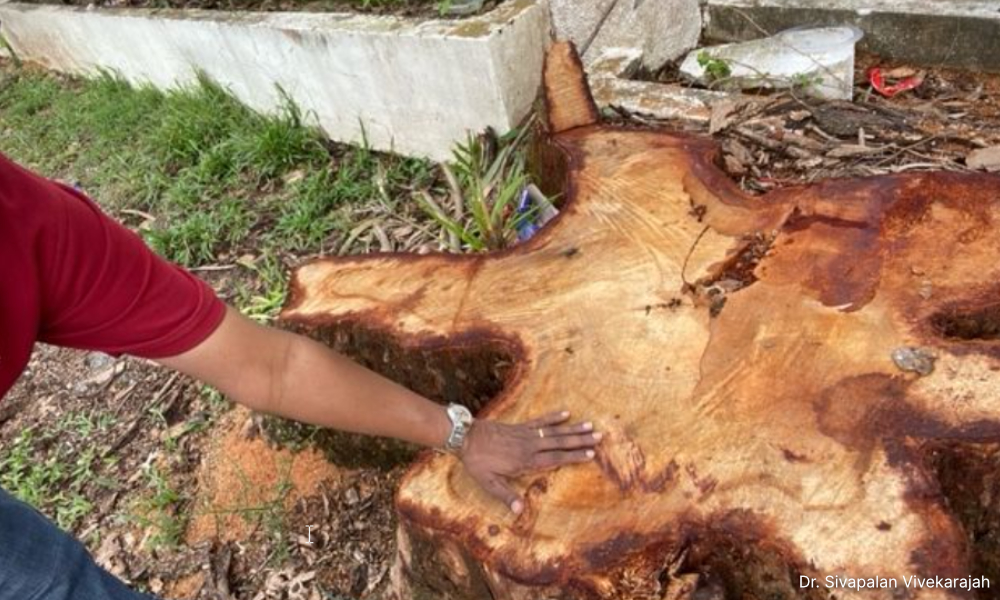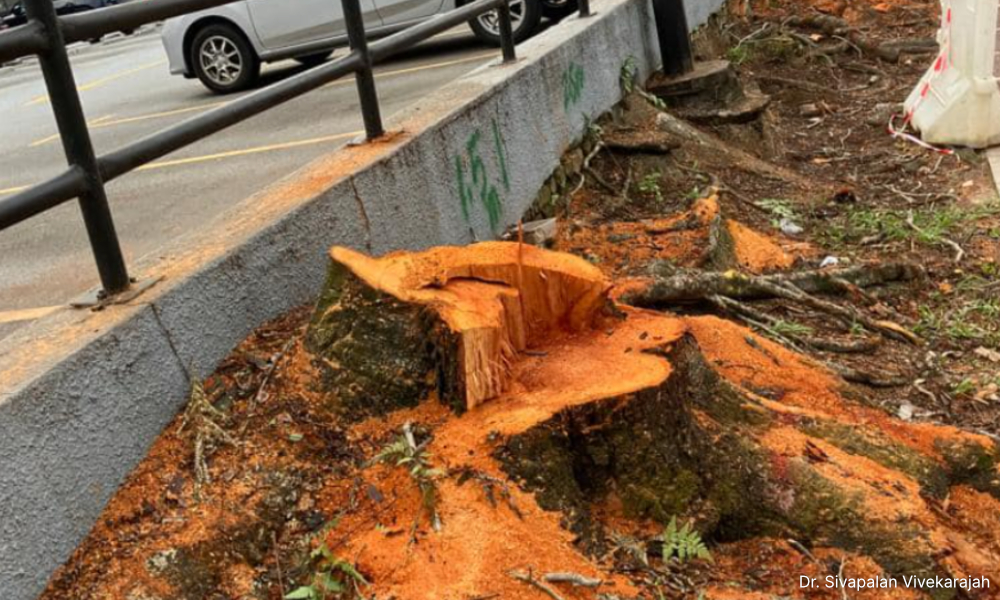LETTER | Over the last 18 months, residents of Taman Tun Dr Ismail, often described as a “leafy, green neighbourhood”, have rudely realised that TTDI, as it’s lovingly known, has lost about 30 to 40 large and mature trees, ostensibly for reasons like laying new pavements, damage to walls or simply because they were supposedly dead.
Many of these reasons are simply false.
For instance, they cut seven angsana trees right at the entrance to Taman Persekutuan Bukit Kiara as it was supposedly damaging the wall. It wasn’t.
Had there been any damage, if they knew the true value of trees, they should have just rebuilt the walls around the trees and not cut the trees. This is right at the front of the Federal Park which hosts thousands of visitors each month. Even a park is not safe.
Another reason was purportedly that the trees were dead. Yes, a few may be dead, but most were not as I live in the same neighbourhood and can testify that they were well and truly alive before they were cut. In fact, many of the stumps kept sprouting shoots as proof.
The other reason was to lay new pavements, especially along Jalan Datuk Sulaiman and Persiaran Abang Hj Openg. Not only did they cut the trees that were on the pavements they also cut trees outside the pavements for good measure. In the first place, why should trees be cut to lay new pavements?
In mature countries, they value their trees and build pavements around them. Even in Kuala Lumpur, along Jalan Ampang near KLCC and along Jalan Perak they built the main roads around the trees, what more simple pavements in a suburb like TTDI.
Then just a few days ago they cut all the trees along Tun Mohd Fuad 1 because they wanted to replace the wall along the car park. Can you believe this excuse? These were 30 to 40-year-old trees cut down for something as silly as repairing a fence.
The people in the Kuala Lumpur City Hall (DBKL) don’t care about trees and don’t care about the neighbourhoods. There are contracts to be given out and if trees are in the way cut them down. Plus, you can give out another contract for cutting trees too. They don’t live in TTDI, so who cares?

Yes, I am being very direct and I am being very bold because if you try to be nice about this issue you’ll get nowhere. I have tried, but it doesn’t work, they just ignore you.
However, these actions by DBKL have much wider repercussions than just trees being cut - in fact, they don’t just damage the environment but they are also likely to cause wider economic losses not just in TTDI but throughout the country when other local councils start emulating DBKL as its the largest city council in Malaysia.
If DBKL can do this then anyone can, and this will cause untoward and unexpected consequences for the nation.
Butterfly effect
You’re probably wondering how cutting trees can cause so much damage including economic losses. Let me explain.
In 1963, Edward Lorenz, a meteorologist and mathematician discovered what is now commonly known as the “Butterfly Effect” which is the idea that small things can have a greater impact on complex systems.
It is called “Butterfly Effect” because the flapping of a butterfly’s wings in one continent can cause a typhoon in another. It would be too complex to get into the theory itself, but essentially what this means is that doing something that is not considered significant can cause something of great significance elsewhere.
In this way, the cutting of trees in one suburb may not be considered something big for some people, but in ways that may surprise you, it could and likely will have a much greater and significant negative impact on the country in the short term. Let us see how this can happen.
Let us start with the local councils themselves. Currently, cutting of trees usually requires some study and approvals at the mid-level of the council. That’s because it requires a budget to pay contractors to cut trees and more than likely a simple contract like new pavements or walls.
If the biggest council in the country can indiscriminately cut trees and no one complains, this makes other councils bolder and before you know it councils everywhere are cutting down trees.
Remember, there’s big money in tree cutting, so this means many contracts can be given out just for the simple act of cutting trees. Where there’s money to be made and contracts to be given out, you can be sure it will be done. And if KL-ites don’t complain then probably residents elsewhere won’t either. If this happens, then we are looking at a surge in tree-cutting in the next few years.
Now let’s look at the impact of the loss of trees itself. Malaysia is a strong proponent of net zero carbon emissions and trees play a role here with carbon capture.
Trees remove carbon dioxide from the atmosphere and store it in their branches, trunks and roots. By cutting trees we are not just removing the potential to remove carbon from the atmosphere, we are also releasing carbon via the decaying of the cut branches and leaves as well as the decaying of the roots.

Cutting trees also means less capture of carbon dioxide which means more carbon dioxide in the air resulting in more unhealthy air. Cutting trees therefore results in net positive carbon release and negative carbon capture, making a mockery of our net zero initiatives.
Greater long-term effect
Now imagine if all local councils around the country become bold enough to follow DBKL and each local council cuts 40 trees in every suburb. We could lose a million trees in just a few years. That is an example of the butterfly effect with the simple act of one local council cutting 40 trees in one single suburb.
There’s more. By cutting trees we are also removing an entire ecosystem of flora and fauna that depend on the trees to forage and live in. We will have fewer birds and mammals that feed on insects and pests like cockroaches and rats.
By cutting these large trees we remove these predators which will result in more pests in TTDI. Soon the restaurants and homes in TTDI will find more cockroaches and other pests and this will lead to more costs in pest control and probably more cases of food poisoning when these pests get to the food stored overnight.
Multiply this a thousandfold and soon there will be more sick people and this has a tremendous health and economic cost to the economy.
When you cut a whole row of trees there’s less shade which means the temperature will rise in TTDI. Higher temperatures and no shade mean roads and pavements get hotter, drier and dustier, leading to dustier neighbourhoods requiring more cleaning and dusting.
Cars will also be dustier thus requiring more washing leading to more water usage and soaps that drain into rivers. On both counts, this is very negative to the environment.
More dust and dirt in the air means more respiratory illnesses like asthma and sinus, which means people with respiratory sensitivities like these will likely avoid visiting TTDI, leading to less business for retailers and food and beverage outlets. This is damaging to the economy of TTDI.
Aesthetically, trees add to the beauty of TTDI and make it a “leafy green neighbourhood” which is highly desirable and thus leads to higher property prices.
Without trees, TTDI loses its allure and this will lead to less demand for homes and lower home prices. Cutting trees thus leads to economic loss in property values so property owners will lose the value of their homes.
Home and shop prices rise due to demand. If TTDI is no longer a “leafy green neighbourhood” but a barren and dusty one, who will want to pay premium prices for property here?
Cutting trees also comes at a cost to local councils as it costs thousands of ringgit of taxpayers’ money to pay contractors just to cut a large tree, remove it from the area and then replant new trees.
So why cut trees in the first place if you’re just going to replant with new trees? There should be better use of the funds especially in current times when the government is financially hard-pressed. If you see the logic in this then you’ll agree that this is an unnecessary exercise.
However, some people are making millions from these tree-cutting and replanting exercises but at a significant financial cost to local councils and taxpayers.
The Butterfly Effect or in our case the “TTDI Tree Cutting Effect” has a greater long-term effect on the health, wealth and social wellbeing of all Malaysians. This makes a mockery of our net-zero policy and is a huge waste of money, but the biggest impact is on the wealth and social well-being of not just TTDI residents but most likely residents of many other suburbs as well.
It is time the relevant ministers take action to stop this unnecessary felling of trees and be true to the government’s promise of net zero and the protection of the environment and the well-being of citizens.
Natural Resources and Environmental Sustainability Minister Nik Nazmi Nik Ahmad, Federal Territories Minister Dr Zaliha Mustapa and Segambut MP Hannah Yeoh (who has been very helpful in attending to this problem thus far) need to engage Kuala Lumpur mayor Kamarulzaman Mat Salleh to stop the further cutting of trees before, not just TTDI but, the rest of the country loses its trees.
Trees are truly a precious resource that makes such a difference in our lives. Stop cutting trees!
DR SIVAPALAN VIVEKARAJAH is a long-time resident of Taman Tun Dr Ismail.
The views expressed here are those of the author/contributor and do not necessarily represent the views of Malaysiakini

